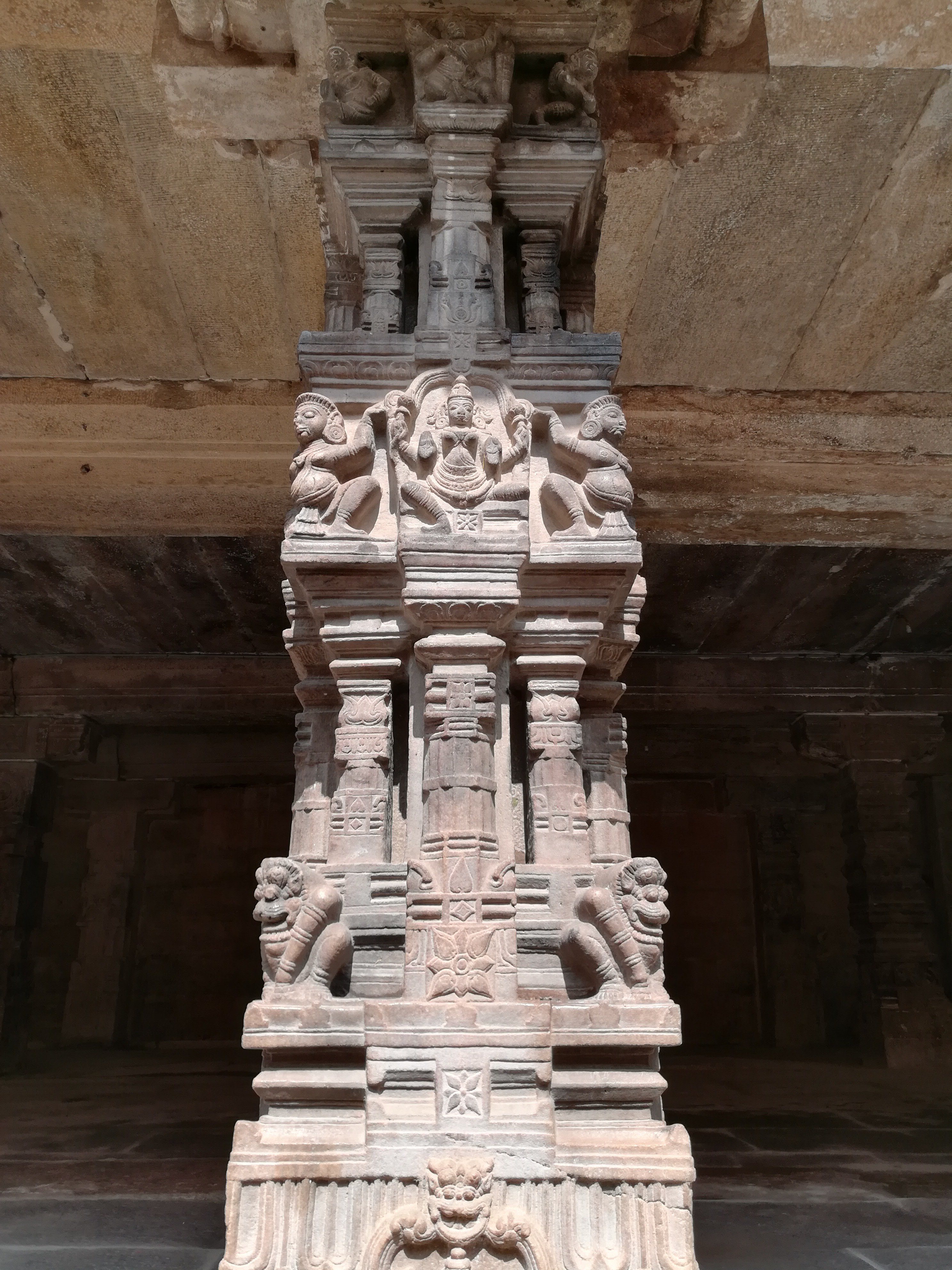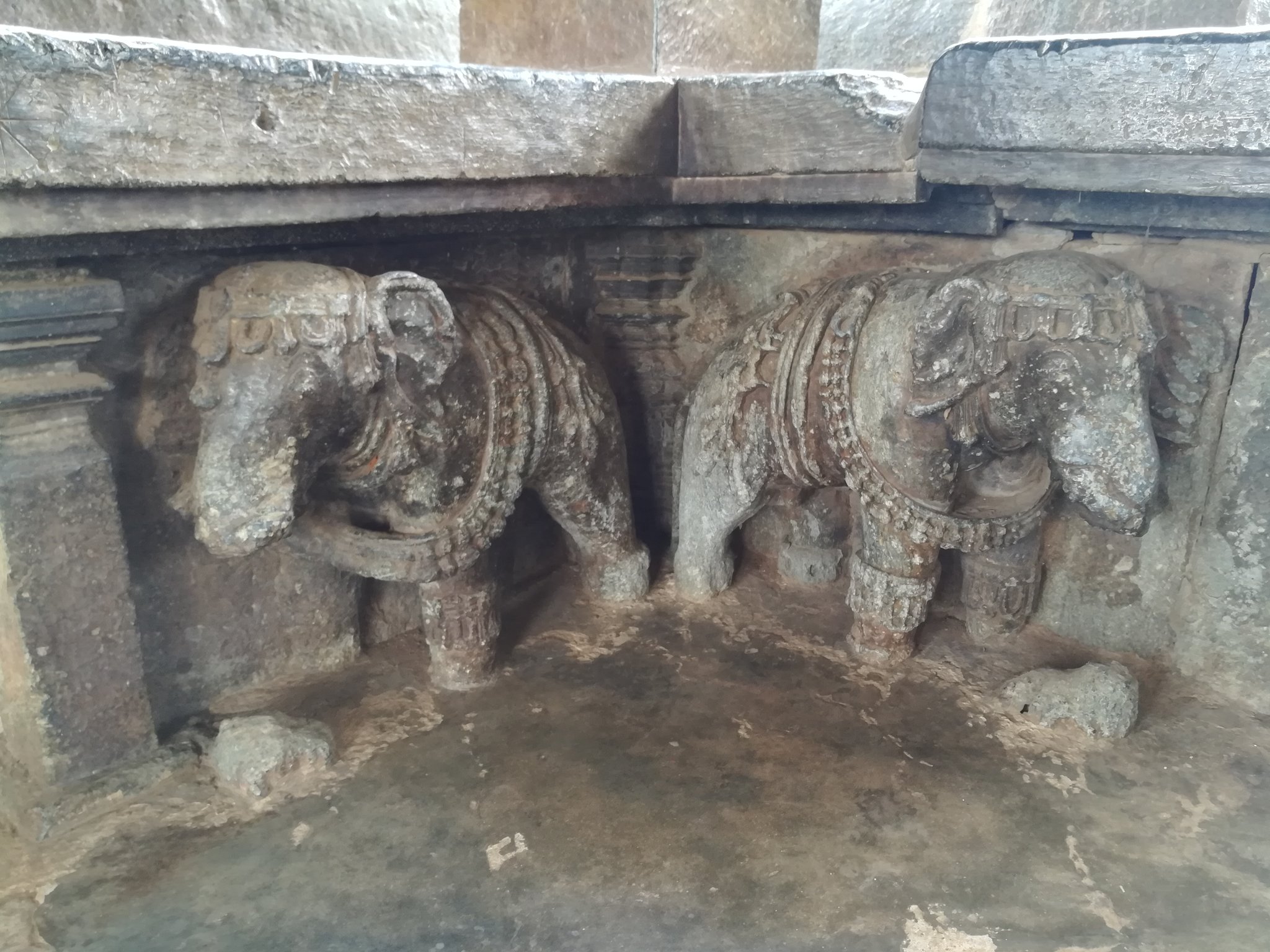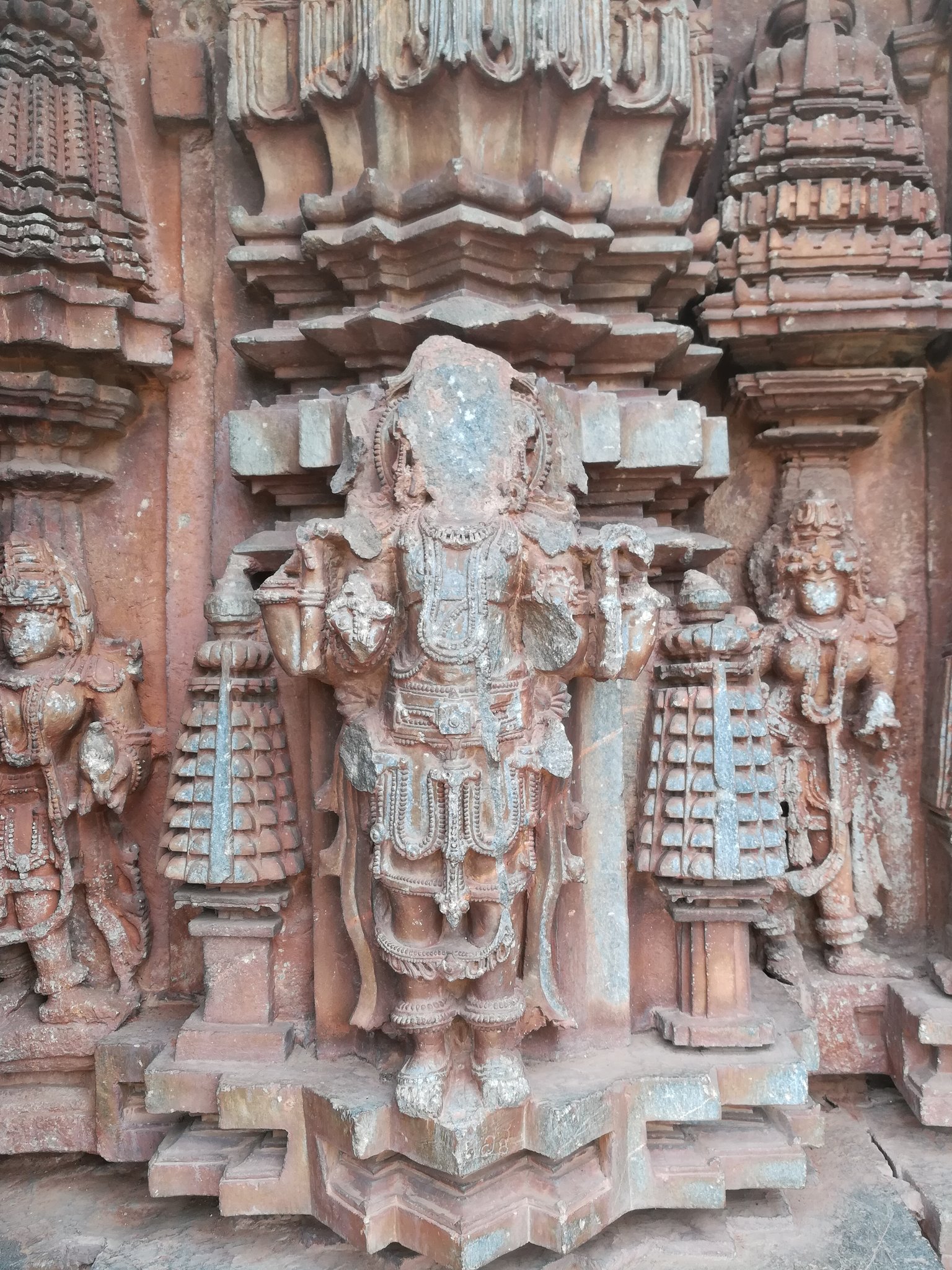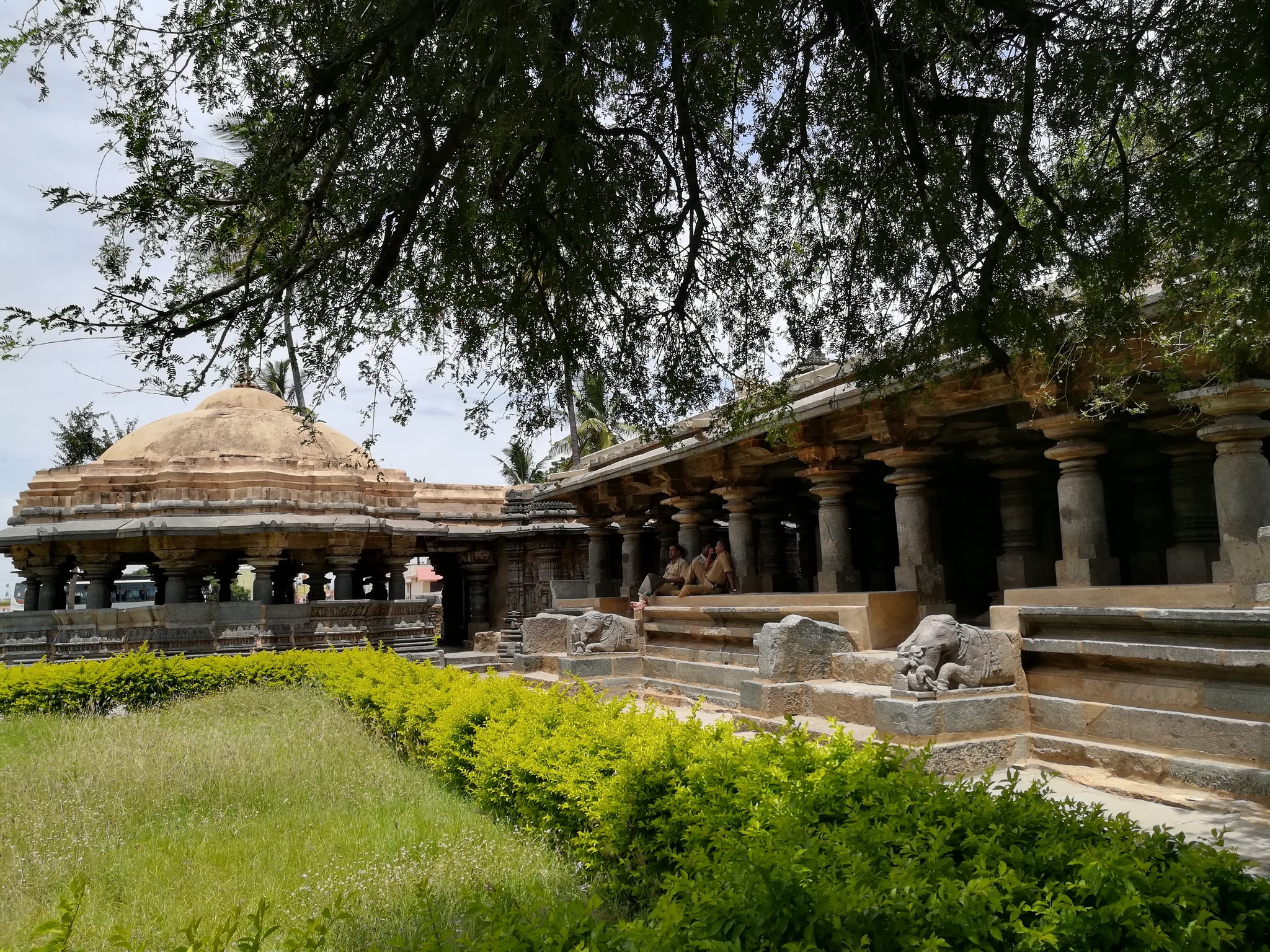 |
| Shree Cheluvanarayanaswamy Temple |
A detailed walk-through of the majestic Cheluvanarayanaswamy temple. The temple is adorned with a number of exquisite pillars whose carvings leave one spellbound.
 |
| Mantapam |
 |
| Shee Yoga Narasimhaswamy Temple |
 |
| View of Melukote town from Yadagiri hill |
This is the entrance to the Cheluvanarayana Swamy temple. The main temple itself dates back to the pre-Hoysala era & enjoyed the patronage of later rulers of Vijayanagara empire & the Mysore Wadiyars. Shri Ramanujacharya spend a significant amount of time here.
 |
| Entrance Gopuram |
The Gopuram is in the typical Hoysala/Vijayanagara style, featuring the Kirtimukha at the very top & Sala fighting the lion. The Sala-lion fight was the royal emblem of the Hoysalas, who were Vaishnavites
 |
| Kirtimukha |
This is the south exit of the Cheluvanarayana Swamy sannidhi. Along the walls are carved the Daśāvatāras of Maha Vishnu. As you can see , the sculptures are a victim of islamic iconoclasm. We'll come to this later.
 |
| Cheluvanarayana Swamy sannidhi |
 |
| Dashavatara carvings |
 |
| Dashavatara carvings |
As you circumambulate around the inner prakaram of the temple you find many a pillars with magnificent & intricate carvings. Among the very first is this of Ugra Narasimha ripping open Hiranyakashipu. Below that, a carving of a calmer Yoga Narasimha.
 |
| Ugra Narasimha |
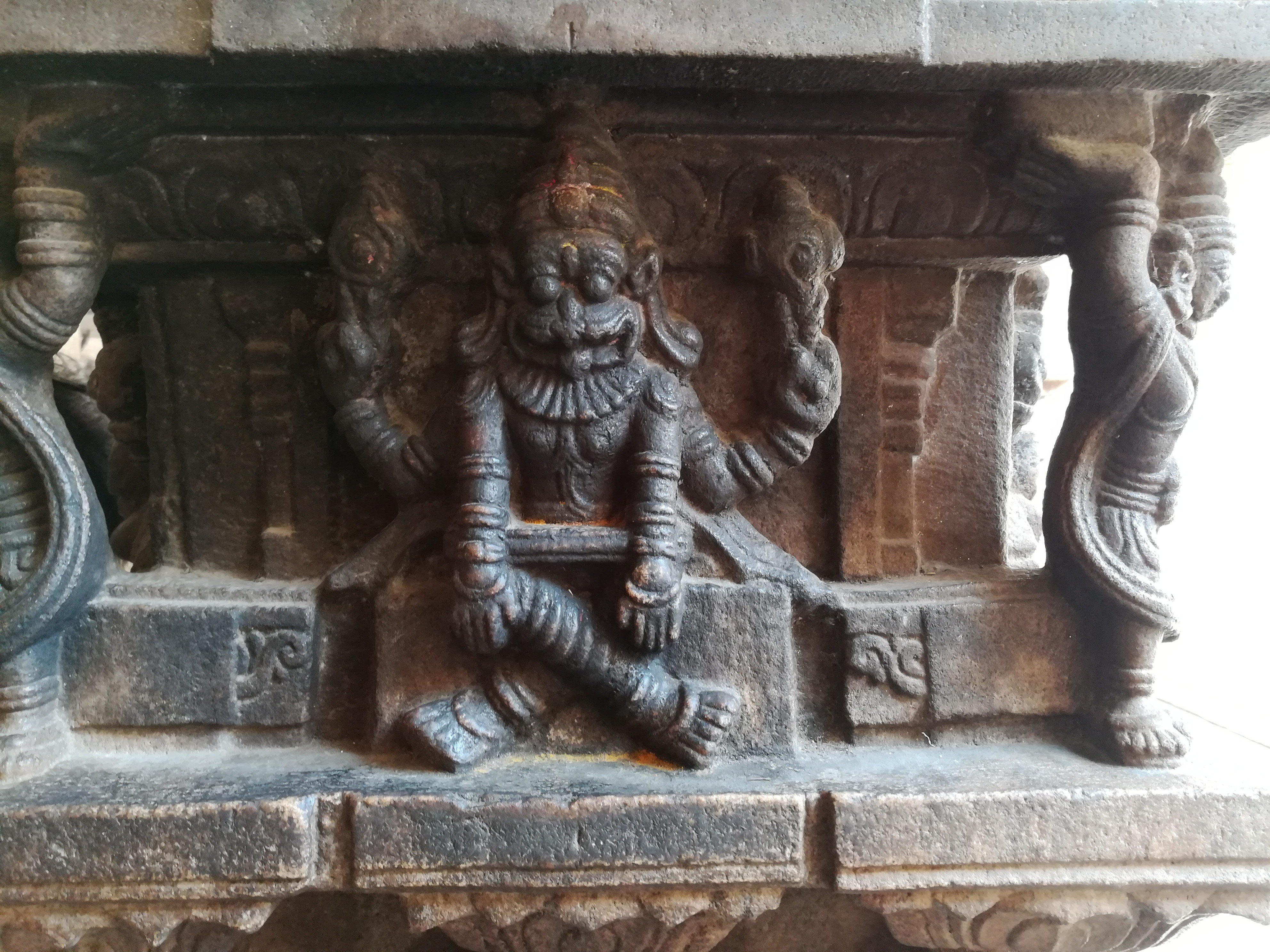 |
| Yoga narasimha |
A pillar with Gopikas dancing while Lord Krishna plays the Flute.
 |
| Venugopala |
 |
| Gopikas |
Lord Vishnu reclining on the Adi Shesha depicted on one of the pillars
 |
| Maha Vishnu |
The below carvings is known as Srivatsa. It is considered to be the symbol of Karma. It is essentially an endless knot. This symbol is found on the chest of Maha Vishnu & in many Vaishnava temples. It represents the interweaving of change and time.The unendingknot represents fullness & prosperity.
 |
| Srivatsa carving |
Even though its a Vaishnava temple, one gets to see a significant number of carvings of Lord Shiva as well.
 |
| Maha Nata Shiva |
A carving of Shri Ramanujacharya blessing his disciple.
 |
| Shri Ramanujacharya |
An optical illusion carving of that of an Elephant & a Bull. This was a very common practice in most South Indian temples.
 |
| Optical illusion carving |
Another carving of what looks to be an extremely complex form of Aśvaḥ
 |
| Ashva |
The consort of Cheluvanarayana Swamy is known as Devi Yadugiri Nachiyar. The dwarapalaka outside the goddess' sannidhi. Sculpture is in typical Hoysala style.
 |
| Dwarapalaka |
On the right side just above the Dwarapalaka we find one more carving of Lord Shiva, this time depicted as Gajasurasamhara. Lord Shiva slays the Rakshasa Gajasura, who takes the form of an elephant & torments Rishis of Varanasi. Lord Shiva rips him open from inside
 |
| Gajasurasamhara Shiva |
Lord Shiva is again depicted above the other dwarapalaka too, this time has Maha-Nata popularly known as Thandaveshwara, with Apasmara beneath him.
 |
| Maha-Nata Shiva |
Now the most stunning pillar of all at the Cheluvanarayana Swamy Temple is this extremely ornate & exquisite pillar. It features this octagonal shaped ring. There are vertical joints that hold it place. No part of the ring itself, touches the pillar.
 |
| Octagonal ring pillar |
 |
| Octagonal ring |
 |
| Octagonal ring |
This special pillar depicts various scenes from the Ramayana. Seen here are Rama, Sita & Lakshmana. Below are Rama & Lakshmana in the battlefield at Lanka.
 |
| Carvings from Ramayana yuddha |
Carving on the same pillar of what appears to be Sugreeva, Angada & Lord Hanuman.
 |
| Sugreeva, Angada & Hanuman |
The other face of the pillar features more carvings from the Ramayana. Seen here Rama & Sita. The octagonal ring is also visible.
 |
| Rama & Sita |
On the same pillar, a scene depicting the slaying of Ravana. Above it is carvings of what appears to be Vibishana, Sita, Rama & Lakshmana post war.
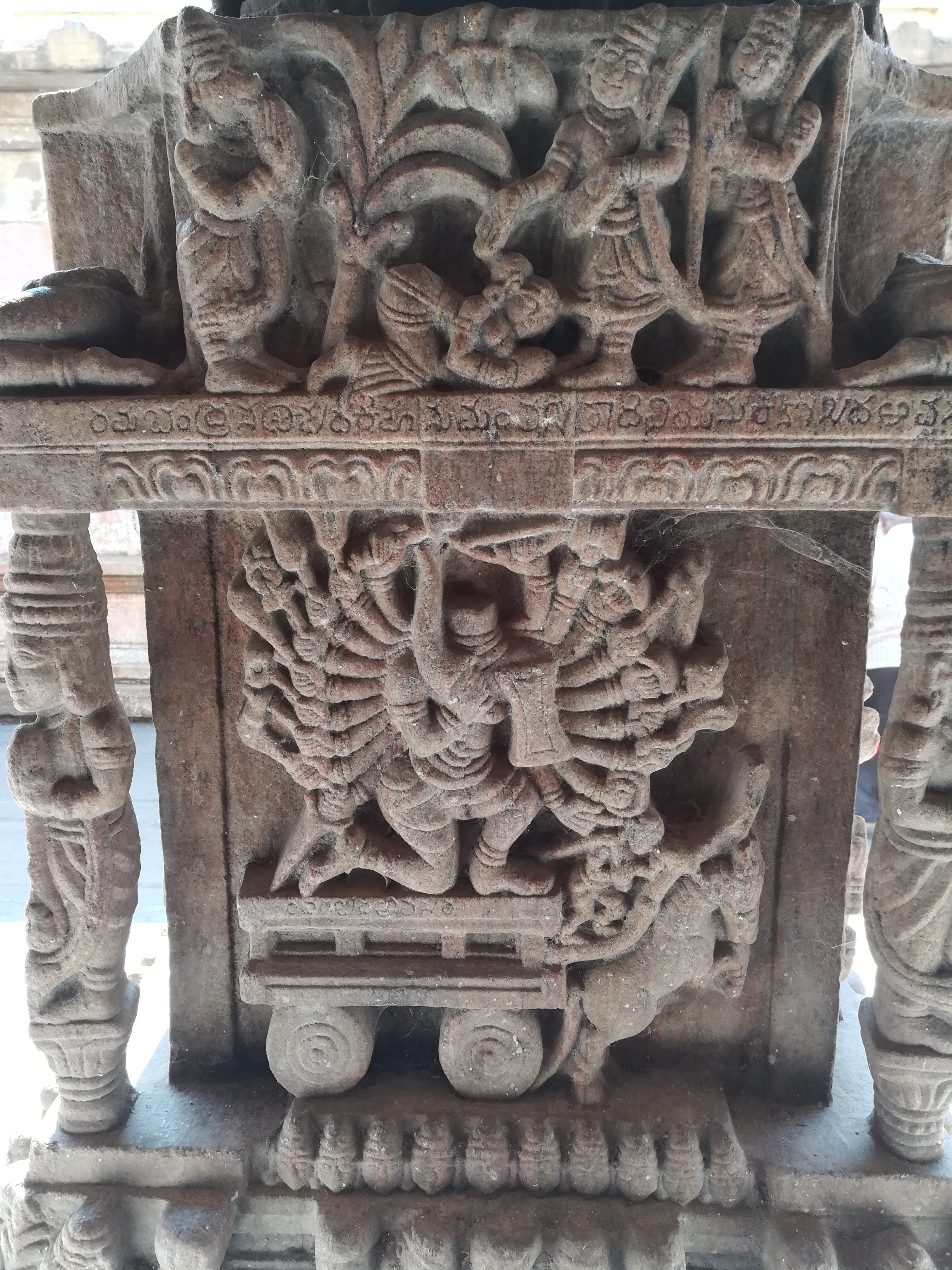 |
| Vibishana, Sita, Rama & Lakshmana |
From the same pillar, carving of the great devotee Shabari offering fruits to Rama & Lakshmana, who are in pursuit of the abducted Sita.
 |
| Shabari offering fruits |
 |
| Isometric view of pillar |
Each pillar is unique & different from the rest here. This one for example has a cylindrical column inscribed within the outer 4 square columns
 |
| Unique pillar |
This pillar for example has a carving of different forms of Maha Vishnu on each of its faces. In order 1) Lakshmi Narayana
2) Bhu Varahaswamy
3) Lakshmi Hayagreeva
4) Lakshmi Narasimha
 |
| Lakshmi Narayana |
 |
| Bhu Varahaswamy |
 |
| Lakshmi Hayagreeva |
 |
| Lakshmi Narasimha |
A carving Ananthashayana Vishnu & Maha Lakshmi at their abode, Vaikuṇṭha
 |
| Ananthashayana Vishnu |
Few more examples of different pillar design. Each pillar is unique. Really a joy for those who enjoy the intricacies.
 |
| Intricate Pillar designs |
The west direction prakaram of the Cheluvanarayana Swamy Temple
 |
| Small mantapam |
Some of the pillar designs on the west side. Notice the complex geometrical design
 |
| Multi column pillar |
 |
| optical illusion carvings |
If you notice astutely, this carving is an optical illusion too. Step away from the screen & watch the inner squares turn into a sphere being pulled apart from every direction by the hook like object. Got to keep the screen at a distance to notice this.
 |
| Rope-sphere-hook optical illusion |
The south side of the temple is where all the magnificent pillars are.
 |
| Pillars & Mantapam |
South side pillars that we had a look at just a few tweets back, more carvings of scenes from the Ramayana.
 |
| More pillars |
The outer walls of the south side of the Cheluvanarayana Swamy temple. Its was restored by the Mysore Maharajas after repeated islamic plunder.
 |
| South side |
Now to the painful part of islamic iconoclasm. This for whatever reasons hasn't been part of the contemporary narrative. While the destruction is so apparent & hits one right in the face, devotees who visit the temple hardly take notice of it. Thats what "secular" conditioning does.
This temple has seen multiple waves of islamic plunder, the first wave was when barbarian alauddin khilji sent his eunuch general malik kafur down south to plunder the Hoysala kingdom. The second wave was after the fall of the Vijayanagara empire & finally tyrant tipoo who massacred 800+ Brahmins of this place.
The islamic iconoclasm becomes very apparent as soon as you exit the south side of the inner prakaram of the Cheluvanarayana Swamy sannidhi, the heads, hands & breasts(of female deities) chopped off, just like Hampi & elsewhere. Typical jihadi work.
 |
| Narasimha damaged by islamic invaders |
 |
| damage by islamic invaders |
 |
| more damage due to islamic invasions |
The west side of the temple, arms of Shri Ramanujacharya chopped off, female figurines completely disfigured in typical jihadi fashion, arms of so many deities chopped off.
 |
| Shri Ramanuja |
Destruction of carvings of the Vaishnavite saints, the Alwars on the north side of the temple. Typical islamic iconoclasm.
 |
| Damaged Alwars |
This is all that is left of what one can only assume to be an Alwar.
 |
| typical jehadi work. |
This is on the outermost prakaram, Lord Narasimha emerging out of the pillar to slay Hiranyakashipu. Arms chopped off by islamists.
 |
| Narasimha emerging out of the pillar |
The very next carving depicts Narasimha chasing hiranyakashipu around before ripping him open. Again maimed by islamists.
 |
| Narasimha chasing around hiranyakashipu |
 |
| Lakshmi Narayana |
This one was particularly disturbing. Lord Krishna's arms & limbs chopped off. Gaumata missing her head. Various other figurines maimed. That thin rope is probably what holds another sculpture from losing its head
#IslamicIconoclasm
 |
| Shri Krishna |
Lakshmi Narasimha, maimed just like the one at Hampi. islamic jihadis particularly went for Lakshmi here. Their hate for female divinity on full display here. Religion of peace indeed.
#IslamicIconoclasm
 |
| Lakshmi Narasimha (maimed by jehadis) |
Some of the carvings were so perversely maimed that they've had to be completely scrapped out from their niches. Particularly the females ones. islamists have particularly maimed them in unspeakable ways. Such contempt for feminine deities & females in general.
#islamiciconoclasm
 |
| Female deities maimed in the most brutal ways |
 |
| more destruction |
Some of the niches are completely devoid of any carvings, yet one can see the remnants of what once must've been a magnificent set of carvings telling a tale of the glory of Maha Vishnu. All wiped out by islamic iconoclasts.
 |
| even more destruction |
 |
| more islamic destruction |
Can only imagine which deity this niche must've housed before its eventual maiming. Notice the parrot carvings & the beheaded female figurine. It tells you something.
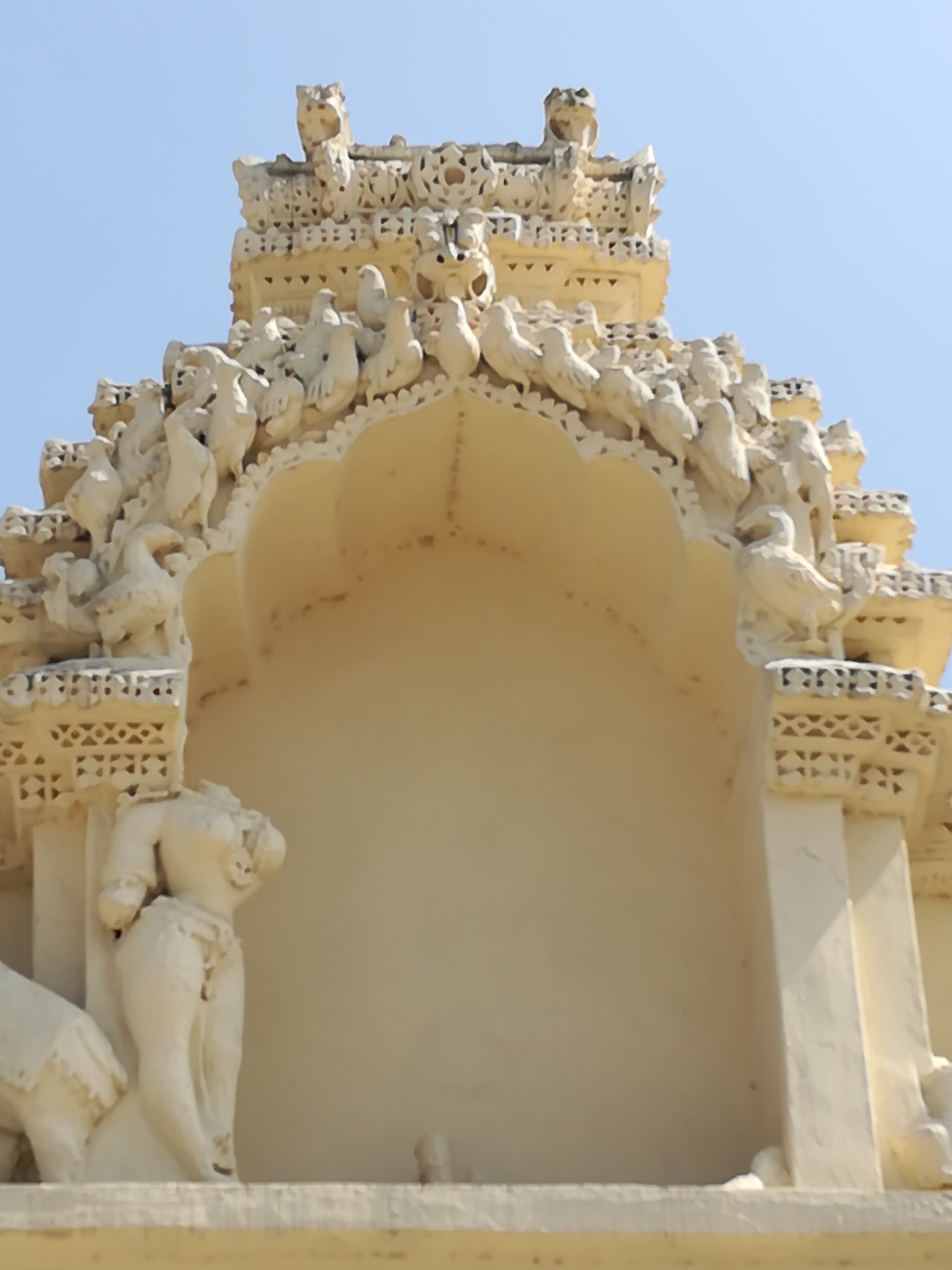 |
| empty niche |
As you look around, all you find is destruction & desolation. A part of history lost forever. Whatever that our ancestors were trying to convey to us through these sculptures, lost forever... let that sink in..its gone..
#islamiciconoclasm
 |
| A part of history permanently lost |
One of the very few carvings to have survived complete destruction (thank you for the small mercies) is that of Lord Ranganatha.
 |
| Ananthashayana Vishnu |
A panoramic view of the south side of the Cheluvanarayana Swamy temple.
 |
| Panoramic view |
More maimed carvings of Lakshmi Narasimha, Vishnu & Rama.
#islamiciconoclasm
 |
| Lakshmi Narasimha, Vishnu & Rama |
A very rare depiction of Lord Narasimha with Lakshmi standing besides him. Its always usually Lakshmi sitting on Narasimha's lap. On the right is a carving of Hanuman carrying Lord Rama on his shoulders. Both maimed by islamic barbarians.
 |
| Narasimha & Lakshmi |
 |
| Hanuman carrying Rama |
Narasimha blessing Bhakta Prahlada.
 |
| Narasimha blessing Bhakta Prahlada |
Then a series of empty niches.... the glorious story of Maha Vishnu abruptly stopped by islamic iconoclasts...
 |
| Unquantifiable are the losses sustained due to islamic atrocities on Hindu Temples |
Finally when one is done completing a full Pradakshina/Parikrama around the temple... The Garuda Sthambam facing Lord Cheluvanarayana Swamy.
 |
| Garudasthambham |
Melukote is also home to the famous Yoga Narasimha Swamy temple. Its situated atop a hill called Yadagiri. It is about 3000ft above sea level & quite a climb.
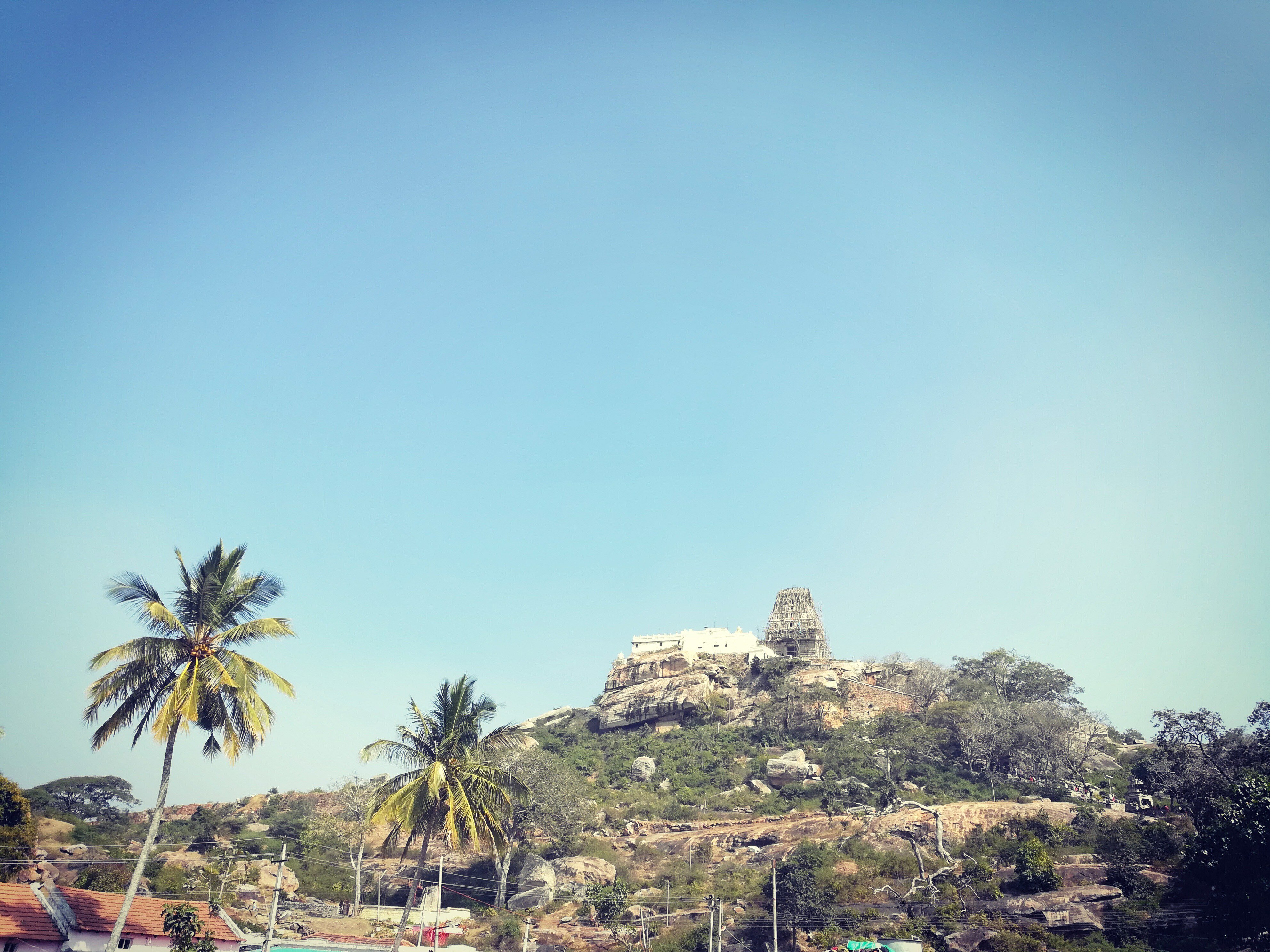 |
| Yoga Narasimhaswamy Temple atop Yadagiri hill. |
Fortunately the area has a nice tree cover to protect devotees from complete exhaustion during a hot day's climb.
 |
| Climb towards the temple |
En route you find these small mantapams every few meters to rest.
 |
| Small mantapam |
Atop the Yadagiri hill. A view of the town of Melukote & its beautiful Pushkarini. The place is a joy for the eyes during monsoons, when every shrub,plant & tree turns lush green.
 |
| View of Melukote town from the hill |
The main Gopuram of the Yoga Narasimha temple built during the Vijayanagara era was undergoing some restoration work.
 |
| Vijayanagara era Gopuram |
Newly constructed smaller Gopuram
 |
| Newly constructed 2nd Gopuram |
Had a nice darshana of Yoga Narasimha Swamy before making my way down to the Pushkarini below.
 |
| Pushkarani |
 |
| Pushkarani |
The Mantapam adjoining the Pushkarini. Notice the Shesha carving in the 3rd pic!! Though on the maintenance aspect much can be done... especially the pushkarini area... mere Bhakthi will not suffice, it is just one aspect of Dharma...
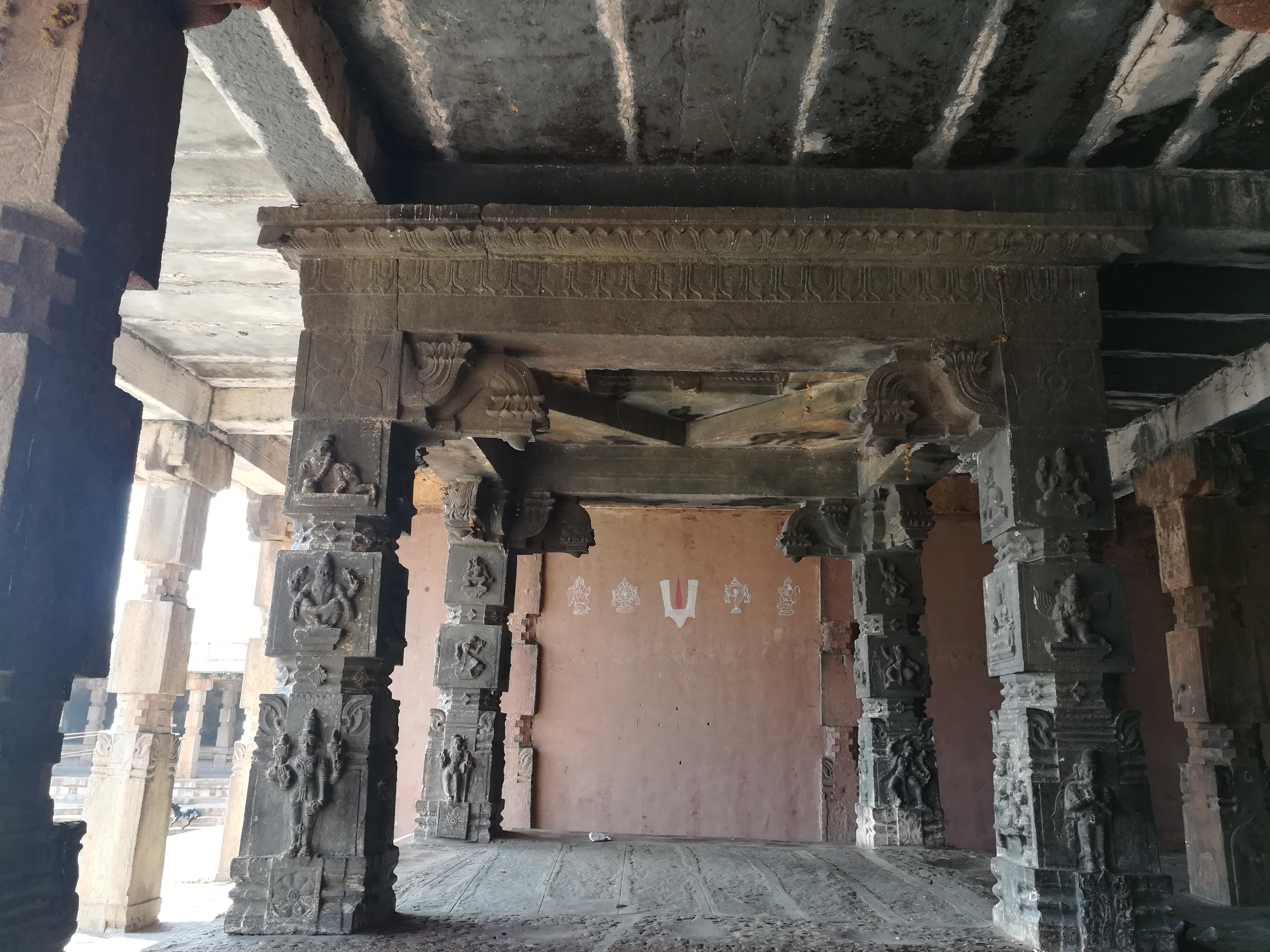 |
| Mantapam adjacent to Pushkarani |
 |
| Carvings on the pillars of the mantapam |
That concludes the post on the Melukote Cheluvanarayana Swamy and Yoga Narasimha Swamy temples. Hope all you found it useful. Thank you for reading. Dhanyavaadam.



















































































